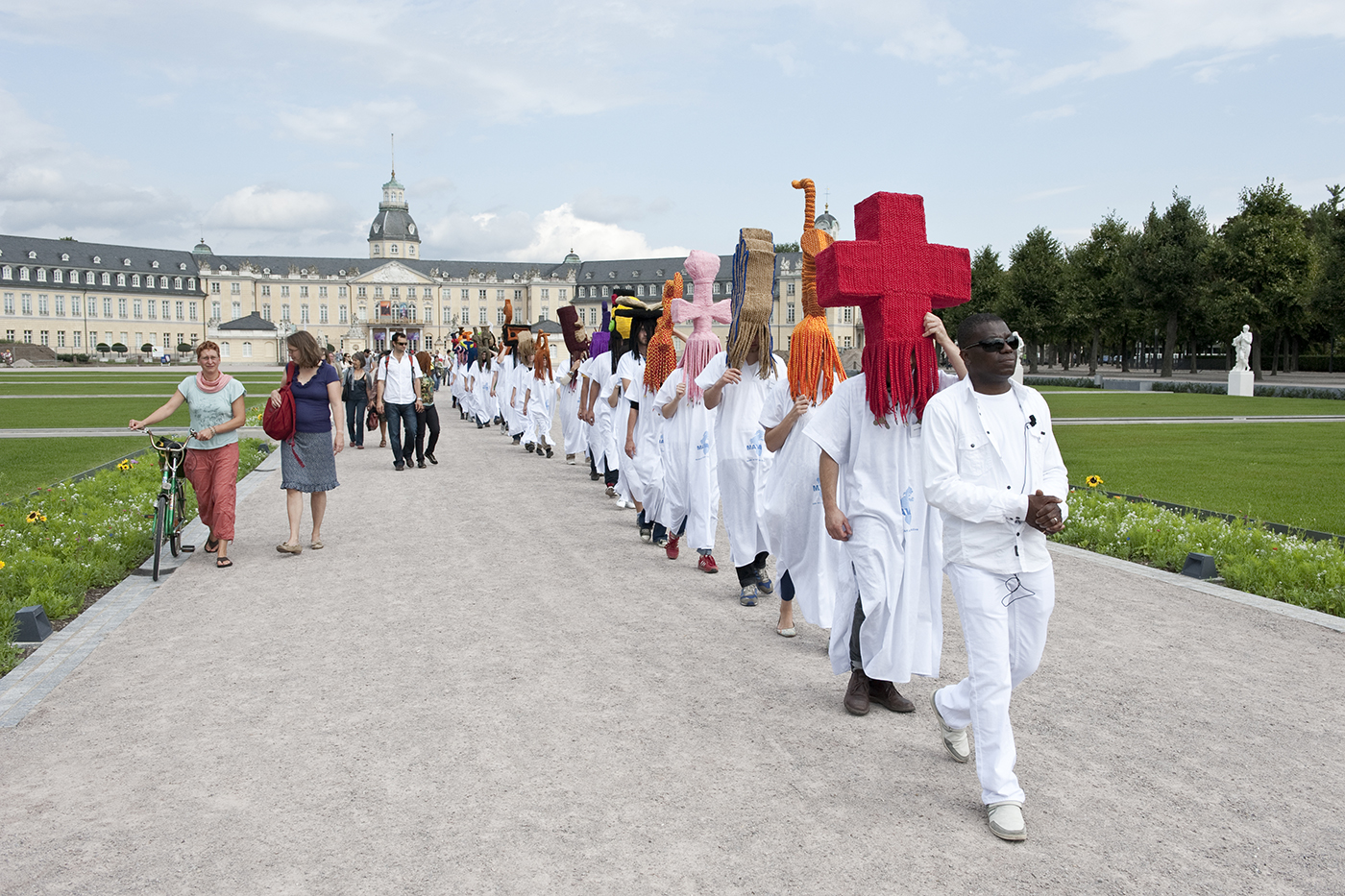Gaba

Meschac Gaba
Procession, 2011
© Joe Miletzki et zkm Karlsruhe, Allemagne
Courtesy de l'artiste & Galerie In Situ - fabienne leclerc, Grand Paris
MAVA -Muse?e d’art de la vie Active
Couvre-chef
“Couvre-chef” can be understood two different ways. First, it literally means headwear, like a hat. And second, the dual meaning of “chef” refers to both the head, in other words reflection and thought, and to the leader and commander. By covering his characters’ heads, Meschac Gaba weaves them symbolic crowns.
The photographer Samuel Fosso recently created a series entitled “African Spirits” in which via self-portraiture he incarnates great black individuals, both African and American—an homage to negritude and those who fought for equal rights. By crossing identity and racial boundaries, Meschac Gaba’s project goes much further as he portrays a fresco of humanity with braided hairstyles.
His message is clear: there are men who have worked for the good of all humanity, no matter where they came from. In that sense Gaba reminds us that there is a united and indivisible community making the world a little less harsh. Nowadays, self gratification or nationalisms of all sort imperil the foundations of an ideal that should be shared by all.
Gaba quite naturally takes things further since the wigs portraying these grandees are hair extensions that unambiguously recall Africa to mind. Is this an effort to remind us that Africa is the cradle of humanity and that we should all therefore think of ourselves as its children? In the same way that May ’68 students all called themselves German Jews in solidarity with Daniel Cohn-Bendit who was ostracized by the powers of the day, Gaba declares us all Africans. But that shouldn’t be confused with identity politics or a desire to dominate others. Rather his approach should be seen as an act of love, a statement of faith that demands an end to differentiation when it leads to repudiation. This is one reply to what the German philosopher Ernst Bloch calls “the inconstruable, the absolute question,” “the problem of the We in itself.”.
Text Simon Njami
This happens to be the case with the braids: the techniques and traditions mostly come from West Africa, but are used (as synthetic extensions) from Harlem, New York, to the Goutte d’or district in Paris. Gaba uses them as an inspiration to create symbolical sculpture/wigs (as is the case in the series MAVA, 2010, Car Wigs, and Architectures, 2008-2009). By observing the cultural itineraries of these objects, their origin and their mutation from one culture to another, he highlights the complexity of their “social biography”. A new life can then begin for them: once the objects are invested with new meanings, they can overstep their “local history” to establish themselves in a global context. In this way, the braids are not only a reference to Africa and objects that are recreated by the current market, but also serve as the basic material for a contemporary work of art, therefore becoming signs of contemporane- ity, in the sense of a globalisation of cultural exchanges. These eccentric headpieces are often shown during processions through the streets. This was the case for the procession organised in 2010 on the occasion of the celebrations of the 50th anniversary of Benin’s independence. Marie Curie, Kwame Nkrumah, Jesus Christ, Louis Pasteur, Karl Marx, Socrates, Guezo, Be?hanzin: each of these personalities was represented by braided signs – coloured headpieces worn by thirty or so models walking through the streets of Cotonou. on this occasion, the public inter- vention was the artist’s way of promoting his Museum of Art and Active Life and calling out to the authorities of the country’s financial capital.
Text Francesca Cozzolino